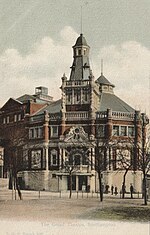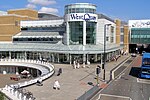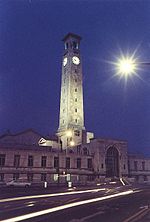Westquay (formerly WestQuay) is a shopping centre in Southampton, England. It has an area of 95,600 m2 (1,029,000 sq ft) of retail and leisure space and contains around 130 shops, including major retailers such as John Lewis and Partners, Marks and Spencer, Zara, Schuh, Waterstone's, Hollister Co., Apple, and others.
It is situated in the city centre, close to the docks, with entrances on the main High Street (Above Bar Street), on Portland Terrace, through Waterstone's and through John Lewis, and on Harbour Parade, through the new (2016-2017) Westquay South. There is a built-in multi-storey car park with an entrance into the centre along with a 3 tier car park beneath. Building work began in 1997 as the former Daily Echo building and Pirelli Cable Works were demolished to make way for the centre. Westquay North was opened on 28 September 2000.
The building is heated using geothermal energy, as is the civic centre. A centralised plant uses heat from an aquifer underground and then distributes it to the buildings in the city centre via a district heating scheme.
The John Lewis store replaced the local department store Tyrrell & Green (a branch of the John Lewis Partnership), which met with mixed emotions from the local people. Marks & Spencer relocated from Above Bar Street to take the second anchor store.
There have been a few major changes to Westquay North's shops since its opening. Tower Records (which faced fierce competition from the HMV store across the street) was replaced with a Nike store, which closed after just a few months. This unit is now Pret A Manger, a sandwich retailer. Waitrose moved to Portswood in 2006 and the old Waitrose space has now been replaced by New Look, which was originally located in a smaller store a floor above. The former New Look store is now River Island. In early 2019 River Island relocated to Above Bar Street and the Unit was divided into two with Lego taking one of the newly-created units. Waitrose did return, however, to Westquay North in 2015 within the lower ground floor of the John Lewis store, branded as Little Waitrose.
In mid-May 2009 the first Hollister store to be opened outside the extended London area opened in Westquay North: this is considered a major coup for Westquay as it reflects well on the strength of the retail offering available.
During the 2020 COVID-19 pandemic Westquay was closed for the first time other than on Christmas Day and Easter Sunday.











